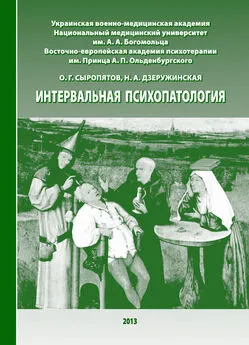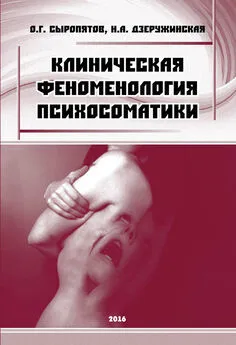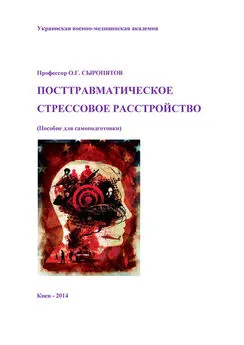Олег Сыропятов - Интервальная психопатология
- Название:Интервальная психопатология
- Автор:
- Жанр:
- Издательство:А. Т. Ростунов
- Год:2013
- Город:Киев
- ISBN:978-966-675-72
- Рейтинг:
- Избранное:Добавить в избранное
-
Отзывы:
-
Ваша оценка:
Олег Сыропятов - Интервальная психопатология краткое содержание
Интервальная психопатология - читать онлайн бесплатно полную версию (весь текст целиком)
Интервал:
Закладка:
Рекомендованная литература
1. Бухановский А.О., Кутявин Ю.А., Литвак М.Е. Общая психопатология. – 2-е изд., перераб. И доп. – Ростов н/Д.: Изд-во ЛРНЦ «Феникс», 1998. – 416 с.
2. Ветгерберг Л. Карманная психиатрия/Пер. со швед. – Упсала, 1997. 176 с.
3. Карманное руководствол к МКБ-10. Классификация психъических и поведенческих расстройств с глоссарием и исследовательскими критериями/Сосг. Дж. Э. Купер. Пер. с англ. – К: Сфера, 2000. – 464 с.
4. Клиническая психиатрия: пер. с англ. доп//гл. ред. Т.Б. Дмитриева. – М.: ГЭОТАР Медицина, 1998. – 505 с.
5. Лаукс Г., Мёллер Х.-Ю. Психиатрия. Справочник./Пер. с нем. – М.: МЕДпресс-информ, 2010. – 512 с.
6. Лексиконы психиатрии Всемирной организации здравоохранения/Пер. с англ. – К: Сфера, 2001. – 398 с.
7. Психиатрия. Под ред. Р. Шейдера. Пер. с англ. – М.: Практикак, 1998. -485 с.
8. Сыропятов О.Г., Дзеружинская Н.А. Клинико-психопатологическая диагностика. – К: ВЕАП – Наук, свгг, 2005. – 240 с.
9. Сыропятов О.Г., Дзеружинская Н.А. Клиническая психиатрия: Избранные слайдовые лекции для врачей. – К.: Наук. Свгг, 2009. – 240 с.
10. American Psychiatric Association. (1987). Diagnostic and statistical manual of mental disorders (3rd ed., rev.). Washington. DC: Author.
11. Beckner M. (1959). The biological way of thought. New York: Columbia University Press.
12. Berner P., & Katschnig H. (1984). Commentary on R. E. Kendell: Reflections on psychiatric classification-For the architects of DSM-IV and ICD-IO. Integrative Psychiatry. 2,51–52.
13. Blashfield R (1986). Structural approaches to classification. In T. Millon & G. L. Klerman (Eds.). Contempory directions in psychopathology: Towards the DSM-IV (pp. 363–380). New York: Guilford Press.
14. Blashfield R., Sprock J., Pinkston K., & Hodgin J. (1985). Exemplar prototypes of personality disorder diagnoses. ComprehensivePsychiatry. 26.11–21.
15. Cantor N. & Genera N. (1986). Psychiatric diagnosis and natural categorization: A close analogy. In T. Millon & G. L. Klerman (Eds.). Contempory directions in psychopathology: Towards the DSM-IV (pp. 233–256). New York: Guilford Press.
16. Cantor N., & Mischel W. (1979). Prototypes in person perception. In L. Ber-kowitz (Ed.). Advances in experimental social psychology (Vol. 12, pp. 3-52). New York: Academic Press.
17. Cantor N., Smith E., French R de S., & Mezzich J. (1980). Psychiatric diagnosis as prototype categorization. Journal of Abnormal Psychology, 89.181–193.
18. Clarkin J. F., Widige T. A., Frances A., Hurt S. W., & Gilmore M. (1983). Prototypic typology and the borderline personality. Journal of Abnormal Psychology, 90. 575–585.
19. Hempe. C. G. (1965). Aspects of scientific explanation and other essays in the philosophy of science. New York: Free Press.
20. Hempel C. G. (1970). Fundamentals of concept formation in empirical science. In 0. Neurath, R. Catnap. & C. Morris (Eds.). Foundations of the unity of science: Towards an International encyclopedia of unified science (Vol. 2. pp. 651–745). Chicago: University of Chicago Press.
21. Horowitz L., Post D., French R., Wallis K. & Seligman E. (1981). The prototype as a construct in abnormal psychology: 2. Clarifying disagreement in psychiatric judgements. Journal of Abnormal Psychology, 90,575–585.
22. Jaspers K. (1963). General psychopathology (J. Hoenig & M. W. Hamilton. Trans.). Chicago: University of Chicago Press.
23. Kendell R. E. (1983). DSM-ПИ: A major advance in psychiatric nosology. In R. L. Spitzer, J. B. W. Williams, A. E. Skodol (Eds.), International perspectives on DSM-Ш. Washington, DC: American Psychiatric Association Press.
24. Lefebre L. B. (1957). The psychology of Karl Jaspers. In P. A. Schilpp (Ed.). The philosophy of Karl Jaspers. The Library of Living Philosophers. La Salle, IL: Open Court Publishing Company.
25. Livesley W. J. (1985). The classification of personality disorder: I. The choice of category concept. Canadian Journal of Psychiatry, 30.353–358.
26. Livesley W. J. (1986). Trait and behavioral prototypes of personality disorder. American Journal of Psychiatry. 143,728–732.
27. Livesley W. J. (1987). Theoretical and empirical issues in the selection of criteria to diagnose personality disorders. Journal of Personality Disorders. I, 88–95.
28. Million T. (1986a). On the past and future of the DSM-Ш: Personal recollections and projections. In T. Millon & G. L. Klerman (Eds.). Contempory directions in psychopathology: Towards the DSM-IV (pp. 29–70). New York: Guilford Press.
29. Millon T. (1986b). Personality prototypes and their diagnostic criteria. In T. Millon & G. L. Klerman (Eds.), Contempory directions in psychopathology: Towards the DSM-IV (pp. 671–712). New York: Guilford Press.
30. Rosch E. (1978). Principles of categorization. In E. Rosch & B. L. Lloyd (Eds.). Cognition and categorization. Hillsdale. NJ: Lawrence Eribaum Associates.
31. Rosch E., & Mervis C. B. (1975). Family resemblances: Studies in the internal structure of categories. Cognitive Psychology, 7,573–605.
32. Schneider K. (1958). Psychopathic personalities (M. W. Hamilton, Trans.). New York: Grune & Stratton.
33. Schneider K. (1959). Clinical psychopathology (M. W. Hamilton, Trans.). New York: Grune & Stratton.
34. Schwartz M. A., & Wiggins О. P. (1985). Science, humanism, and the nature of medical practice: A phenomenological view. Perspectives in Biology and Medicine, 28,331–361.
35. Schwartz M. A., & Wiggins O. P. (1986). Logical empiricism and psychiatric classification. Comprehensive Psychiatry, 27,101–114.
36. Schwartz M. A., & Wiggins O. P. (1987). Diagnosis and ideal types: A contribution to psychiatric classification. Comprehensive Psychiatry, 28, 277–291.
37. Schwartz M. A., & Wiggins O. P. (1988). Scientific and humanistic medicine: A theory of clinical methods. In K. L. White (Ed.). The task of medicine: Dialogue at Wickenburg. Menio Park, CA: Henry J. Kaiser Family Foundation.
38. Stengel E. (1963). Hughlings Jackson\'s influence in psychiatry. British Journal of Psychiatry, 109,348–355.
39. Weber M. (1949). The methodology of the social sciences (E. Shils, Ed.). New York: Free Press
40. Weber M. (1958). The Protestant ethic and the spirit of capitalism (T. Parsons, Trans.). New York: Scribner\'s. Weber M. (1978). Economy and society: An outline in interpretive sociology. Berkeley, CA: University of California Press.
41. Widiger T. A. (1982). Prototypic typology and borderline diagnoses. Clinical Psychology Review, 2,115–135.
42. Wittgenstein L. (1953). Philosophical investigations. New York: Macmillan.
43. Zubin J. (1984). Commentary on R. E. Kendell: Reflections on psychiatric classification-For the architects of DSM-IV and ICD-10. Integrative Psychiatry, 2,52–53.Часть II Феноменологическая психиатрия
«Феноменология – это единственный метод, с помощью которого можно увидеть суть другого человека…»
Ленгле А.
Введение
Являясь полидисциплинарными феноменами как внутри философии, так и за ее пределами, феноменологическая психиатрия и экзистенциальный анализ конституируют совершенно своеобразную теоретически практическую систему. Понимание ее опорных моментов, системы подходов и концептуальной сетки необходимо, если ставится цель понять их историко философское значение (Власова O.A., 2010).
Как альтернатива позитивизму, экзистенциально-феноме-нологическая психиатрия предлагает новые онтологические основания, которые схематично можно представить в следующем виде:
1) Патологическая реальность сознания и патологическое существование является объективной реальностью, переживаемой больным.
2) То, что называется психической патологией в позитивистской психиатрии, есть результат трансформации онтологических оснований опыта индивида, приносящей ему вследствие расхождения онтологического модуса с общепринятым невыразимые страдания.
3) Эта трансформация происходит в двух основных направлениях – изменении пространственное™ и темпоральности опыта.
4) Для понимания типа особенностей этих изменений необходимо вживание в опыт больного, понимания его отношений с миром.
5) Задачей психиатра является изменение отношений с миром, изменение опыта больного, по своей сути – своеобразная онтологическая адаптация.
Развивая в психиатрии основные идеи феноменологии Гуссерля и Шелера, фундаментальной онтологии Хайдеггера или интуитивизма Бергсона, феноменологические психиатры и экзистенциальные аналитики неизменно заимствуют онтологические идеи, обращаются прежде всего к онтологии. И даже когда заимствование идет через методологию или гносеологию, как, например, происходит с феноменологией Гуссерля, начальным моментом обращения к этим идеям становится онтологический интерес. Именно этот онтологический интерес отличает феноменологическую психиатрию и экзистенциальный анализ как единую традицию от возникшей позднее антипсихиатрии, где онтология вдет в едином комплексе с антропологией, социальной философией и этикой, и первичность установить невозможно.
Читать дальшеИнтервал:
Закладка:










